








See also Oklahoma-Tribes.com

I quoted the legends (descriptions) on the cards where available. It should be kept in mind as you read these descriptions that they were written in the early part of the 20th century.
Where possible, I will create links to information about the nations represented, just click on the name of the nation in the description. To see larger images of the postcards, click on the card image.
 |
Left: Navajo, the legend on the back reads: "Pretty Eyes Be-nah Na-zuhn, The Navajo Indian baby is carried in a cradle similar to this from birth until large enough to learn to creep. Tho wrapped and bound, even in the summer, they seem quite happy and greet all strangers with a smile" The card is a "linen", often produced by pressing the paper against cloth in the process, it has the texture of linen on the face of the card. Colours on linen cards were often very vibrant. |  |
Left:Pima, mother and child. Postmarked 1915. As seen from this card, the cradleboards also serve as support while the mother holds her infant in her arms or on her lap. There is a fairly large hood on this particular board, and shows some signs of "European" influence in the lace and fabric touches. The bands are rather fancy in comparison to some of the other cards. The legend on the back of the card reads: "the Cradle of the Indian children consists of a board made of slats, with hood of same material or wicker. the youngster being bound with bands there to uncomfortable in appearance yet the children seem fat and happy. they are usually carried on their mothers back wrapped in a bright shawl." |
 |
Left: Unidentified, but postmarked Arizona in 1906, this card is "embossed" (the infant and cradle are pressed out from the back to give the card texture). Copyright on the picture is H.H. Tannen, 1903. Although the card is well-worn and soiled, I enjoy it for its detail and the happy infant. The cradleboards often provided raised hoods to protect the child from weather. |  |
Left:"Embryonic Warrior", unidentified copyright Detroit Photographic Co. 1902, this card was written out in 1918, but not posted. This board bears a striking resemblance to the one from Arizona and possibly is from the same nation. |
 |
Left:Yakima, this cradle utilizes materials available in the Northwest of what is now the U.S.A. The headboard is probably woven cedar. This infant appears to be very pampered. This card was posted in 1909. |  |
Left: Unidentified, this card was posted in Oklahoma in 1910. The cradleboards appear to be mostly oblong, with a high square hood decorated with baubles similar to the Yakima cradle. It is unusual to see twins, and in some tribes twins were considered unlucky. |
 |
Left:Sioux twins, Little Bear and White Bull", postmarked 1908. The wrappings and board are quite decorated, and the board is constructed with two extended pieces. If anyone has any idea of the purpose other than decorative for these extended pieces, please let me know. They also appear in the Cheyenne and Kiowa cradleboards, as well as one of the Navajo cards. |  |
Left:"Baby of Bird Chief, Cheyenne Indian", this child also appears very contented. Decorative wrapper, the extended pieces on this board are positioned similarly to the Kiowa board below. This wrapper appears to be heavily beaded, but it does not say so, therefore I may be mistaken. It is however very thick. This is also a very early card; unused, it is an early "divided back", printed in Germany as so many early cards were. |
 |
Left:"Kiowa Papoose Asleep", this child looks completely snug. Very decorative, this board also features the extended pieces. Whereas the Sioux boards had straight extensions, this one forms a slight "V" shape, farther apart at the top than the bottom. See also Oklahoma-Tribes.com |
 |
Left:"A Navaho Papoose, Arizona" (click on "history"), copyright Fred Harvey. Similar in construction to the cards above, the hood of the Navajo board nevertheless remains the same as the rounded cradleboards. Legend on the back of the card reads: "The Navaho child is seldom punished for the simple reason that he seldom requires it. There appears to be a bond of sympathy and love between parent and child which is very strong during the minority of the child, but strange to say the children do not always love and protect their parents when the latter become old and infirm." See also Navajo culture |
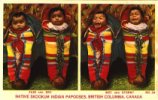 |
Skookum, "Native Skookum Indian Papooses, British Columbia, Canada". This is Kodachrome version of an earlier card, not particularly flattering in its titles, but very nice depiction of the colourful wrapping. Note the hide around the feet to protect the infants from cold and damp. There is no hood on these boards, probably the child's head is simply protected by blankets or hide. The head of the board is bent wood loop, and possibly the entire frame is bent wood, with webbing for support. As Chinook jargon, I can't be sure this is the correct name, and can find very little information on the Skookums or whether they were actually a single nation or a group of nations,... my best guess is the Shishalh (Sechelt) nation. "Skookum" in Chinook Jargon means "powerful" or similar words. The range appears to run along the coastal area from Oregon north to northern British Columbia. Please feel free to enlighten me if you know of any references to these people. I have heard of them most of my life.
| |
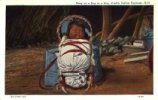 |
Pueblo, "Snug as a Bug in a Rug". Legend on back reads: The cradle or carrier of the Pueblo Indian babies is either a board, or rawhide stretched on a wooden frame. Sometimes, they have a frame of wicker, or cloth stretched on a wooden frame, as a hood. The child is bound in this carrier, and altho they appear uncomfortable, they are seldom heard to cry. When the carrier is used as a cradle, it is simply tied to the beams of the roof of the little huts in which the Pueblo Indians live, by long ropes. The cradle can then be swung like a pendulum. The Pueblo Indian is very fond of his children who obey their parents absolutely and uncomplainingly. They are seldom punished or spoken to harshly. | |
 |
Ute, copyright 1902, this is my earliest "papoose" card at present, postmarked 1904. These boards are quite wide at the top and narrow at the bottom. The hoods are much smaller than some, but still serve the purpose. I have enlarged two images from this card below, but it is difficult to get a clear image due to the lack of clarity in the original image.   For more information on the Ute tribes, please visit | |
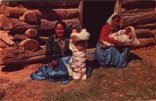 |
Navajo, this card is probably from the 1950s. It is easily seen that the design of the cradleboards had not changed much through the years. Indeed they are much the same today. Legend on the back reads: "Navajo Women sit in front of their log and mud Hogan. Babies are carried on cradle-boards. The Navajo Reservation covers 25,000 square miles of country in Arizona, New Mexico and Utah. | |
 |
Seminole, "'Seminole Nation' holds 'Mother's Day', Florida." Another "Linen" card, there are no cradle boards in this view. I have never seen cradleboards used in any of the Seminole nation cards; I don't know if this means they are not used, or if they simply have not shown them in cards. I would like to hear from anyone who has this information. The legend on the back reads: "The only 'Indian Nation' that has not signed a Peace Treaty with the U.S.A. still carries on in primitive fashion, the tribal lure of its ancestors in the Everglades, Florida." The card was probably published in the 1940s. See further links at Seminole Nation - Indian Territory |
One more site of related interest: North American Indian Children's Organization (NAICO)
Recent additions to my collection:
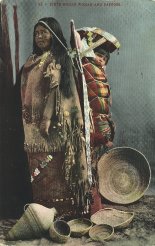 |
Left: Piute Woman and Papoose. This card was posted from California in 1909. There is no description on the card, simply 85 - "Piute Indian Woman and Papoose" The card is published by Edward H. Mitchell, a well-known postcard publisher of the time. In the view one can see the beautifully tight baskets, some tight enough to carry water, made by the Paiute, as well as several pieces of decorative beadwork. | 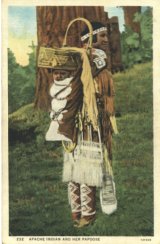 |
Left:Apache, mother and child. There appears to be a bentwood or woven wood frame to which the cradle is attached, with a similar material constructing the hood. The card is unused so I am uncertain of the date. There is a very slight woven texture to the card face. This card and the previous one give a good look at how the infant is carried. |
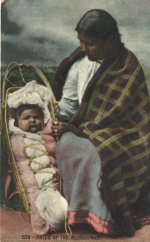 |
Left: This card was published by Thompson's Studio, Vancouver, B.C., and the word "Canada" is pencilled on the back. The mother and baby in this scene could have been from any of several tribes in the West Coast area, but probably from the coastal area of what is now British Columbia. Note the basket shaping of this particular cradle board. Probably Coast Salish If anyone can enlighten me on this card, please contact me, I'd appreciate it. |  |
Left:Card is from Val d'Or, Quebec, and is a much more recent photo (card was posted in 1951). According to the Val d'Or Native Center, and verified by a member of the nation, it is Algonquin. |
 |
Left: I was interested to see this card from Temuco, Chile with a very similar cradleboard, so thought I would include it here. The people pictured are possibly of the Mapuche Nation. I've made an enlargement of the "papoose". |  |